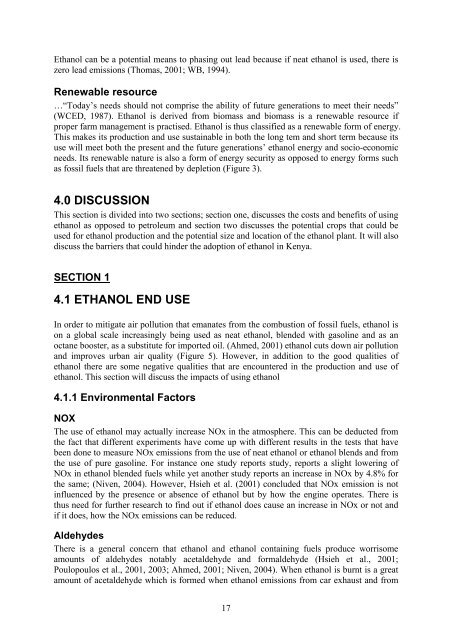ethanol fuel production and use in kenya for sustainable ... - lumes
ethanol fuel production and use in kenya for sustainable ... - lumes
ethanol fuel production and use in kenya for sustainable ... - lumes
You also want an ePaper? Increase the reach of your titles
YUMPU automatically turns print PDFs into web optimized ePapers that Google loves.
Ethanol can be a potential means to phas<strong>in</strong>g out lead beca<strong>use</strong> if neat <strong>ethanol</strong> is <strong>use</strong>d, there iszero lead emissions (Thomas, 2001; WB, 1994).Renewable resource…“Today’s needs should not comprise the ability of future generations to meet their needs”(WCED, 1987). Ethanol is derived from biomass <strong>and</strong> biomass is a renewable resource ifproper farm management is practised. Ethanol is thus classified as a renewable <strong>for</strong>m of energy.This makes its <strong>production</strong> <strong>and</strong> <strong>use</strong> susta<strong>in</strong>able <strong>in</strong> both the long tem <strong>and</strong> short term beca<strong>use</strong> its<strong>use</strong> will meet both the present <strong>and</strong> the future generations’ <strong>ethanol</strong> energy <strong>and</strong> socio-economicneeds. Its renewable nature is also a <strong>for</strong>m of energy security as opposed to energy <strong>for</strong>ms suchas fossil <strong>fuel</strong>s that are threatened by depletion (Figure 3).4.0 DISCUSSIONThis section is divided <strong>in</strong>to two sections; section one, discusses the costs <strong>and</strong> benefits of us<strong>in</strong>g<strong>ethanol</strong> as opposed to petroleum <strong>and</strong> section two discusses the potential crops that could be<strong>use</strong>d <strong>for</strong> <strong>ethanol</strong> <strong>production</strong> <strong>and</strong> the potential size <strong>and</strong> location of the <strong>ethanol</strong> plant. It will alsodiscuss the barriers that could h<strong>in</strong>der the adoption of <strong>ethanol</strong> <strong>in</strong> Kenya.SECTION 14.1 ETHANOL END USEIn order to mitigate air pollution that emanates from the combustion of fossil <strong>fuel</strong>s, <strong>ethanol</strong> ison a global scale <strong>in</strong>creas<strong>in</strong>gly be<strong>in</strong>g <strong>use</strong>d as neat <strong>ethanol</strong>, blended with gasol<strong>in</strong>e <strong>and</strong> as anoctane booster, as a substitute <strong>for</strong> imported oil. (Ahmed, 2001) <strong>ethanol</strong> cuts down air pollution<strong>and</strong> improves urban air quality (Figure 5). However, <strong>in</strong> addition to the good qualities of<strong>ethanol</strong> there are some negative qualities that are encountered <strong>in</strong> the <strong>production</strong> <strong>and</strong> <strong>use</strong> of<strong>ethanol</strong>. This section will discuss the impacts of us<strong>in</strong>g <strong>ethanol</strong>4.1.1 Environmental FactorsNOXThe <strong>use</strong> of <strong>ethanol</strong> may actually <strong>in</strong>crease NOx <strong>in</strong> the atmosphere. This can be deducted fromthe fact that different experiments have come up with different results <strong>in</strong> the tests that havebeen done to measure NOx emissions from the <strong>use</strong> of neat <strong>ethanol</strong> or <strong>ethanol</strong> blends <strong>and</strong> fromthe <strong>use</strong> of pure gasol<strong>in</strong>e. For <strong>in</strong>stance one study reports study, reports a slight lower<strong>in</strong>g ofNOx <strong>in</strong> <strong>ethanol</strong> blended <strong>fuel</strong>s while yet another study reports an <strong>in</strong>crease <strong>in</strong> NOx by 4.8% <strong>for</strong>the same; (Niven, 2004). However, Hsieh et al. (2001) concluded that NOx emission is not<strong>in</strong>fluenced by the presence or absence of <strong>ethanol</strong> but by how the eng<strong>in</strong>e operates. There isthus need <strong>for</strong> further research to f<strong>in</strong>d out if <strong>ethanol</strong> does ca<strong>use</strong> an <strong>in</strong>crease <strong>in</strong> NOx or not <strong>and</strong>if it does, how the NOx emissions can be reduced.AldehydesThere is a general concern that <strong>ethanol</strong> <strong>and</strong> <strong>ethanol</strong> conta<strong>in</strong><strong>in</strong>g <strong>fuel</strong>s produce worrisomeamounts of aldehydes notably acetaldehyde <strong>and</strong> <strong>for</strong>maldehyde (Hsieh et al., 2001;Poulopoulos et al., 2001, 2003; Ahmed, 2001; Niven, 2004). When <strong>ethanol</strong> is burnt is a greatamount of acetaldehyde which is <strong>for</strong>med when <strong>ethanol</strong> emissions from car exhaust <strong>and</strong> from17
















